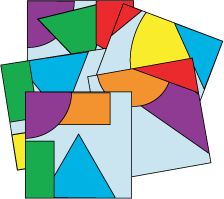Or search by topic
Number and algebra
Geometry and measure
Probability and statistics
Working mathematically
Advanced mathematics
For younger learners
Jig Shapes



This challenge is best done in a group of at least four children.

You'll need to print out this sheet or, if you would like much larger cards, these sheets. The sheets will need to be cut into twelve separate cards.
Share all the cards out amongst the group.
Can you each work out what shape or shapes you have part of on your card?
Can you describe the shapes without showing it to anyone else?
What will the rest of the shape or shapes look like do you think?
How could you sort the cards?
We would love to hear your descriptions and hear about the ways you sorted or arranged the cards.
This problem is also available in French, called Casse-tête de formes.
You may also like
Biscuit Decorations
Andrew decorated 20 biscuits to take to a party. He lined them up and put icing on every second biscuit and different decorations on other biscuits. How many biscuits weren't decorated?

